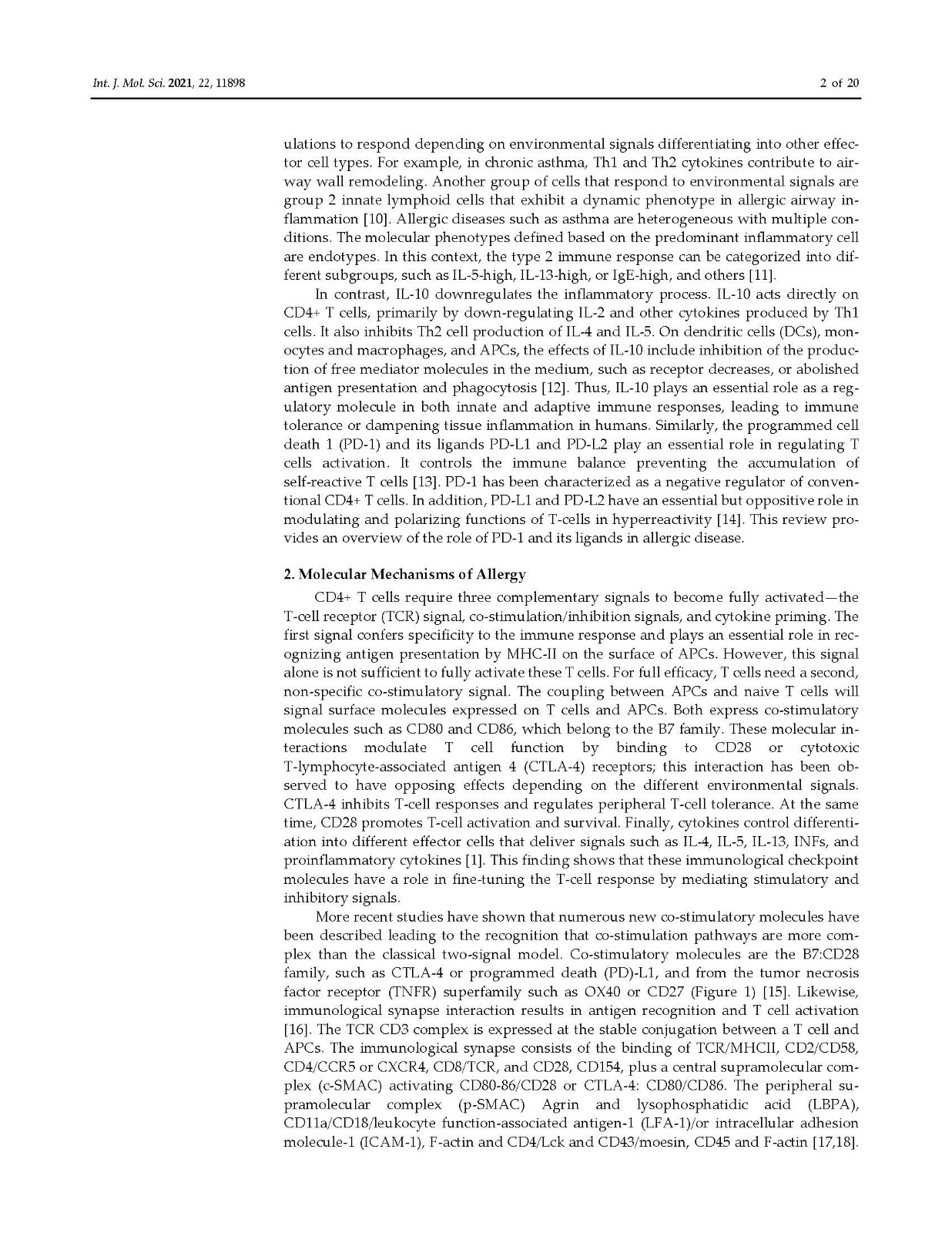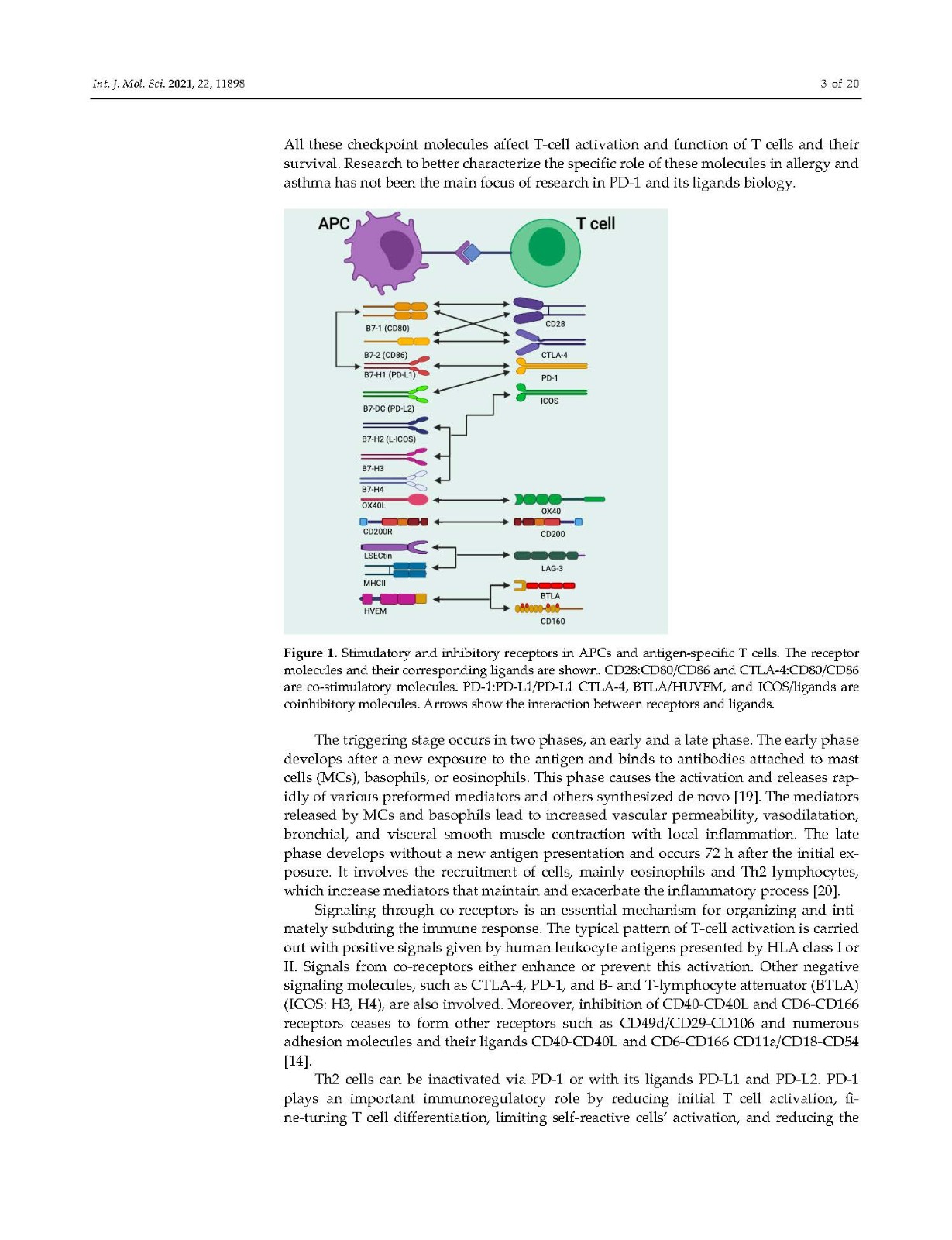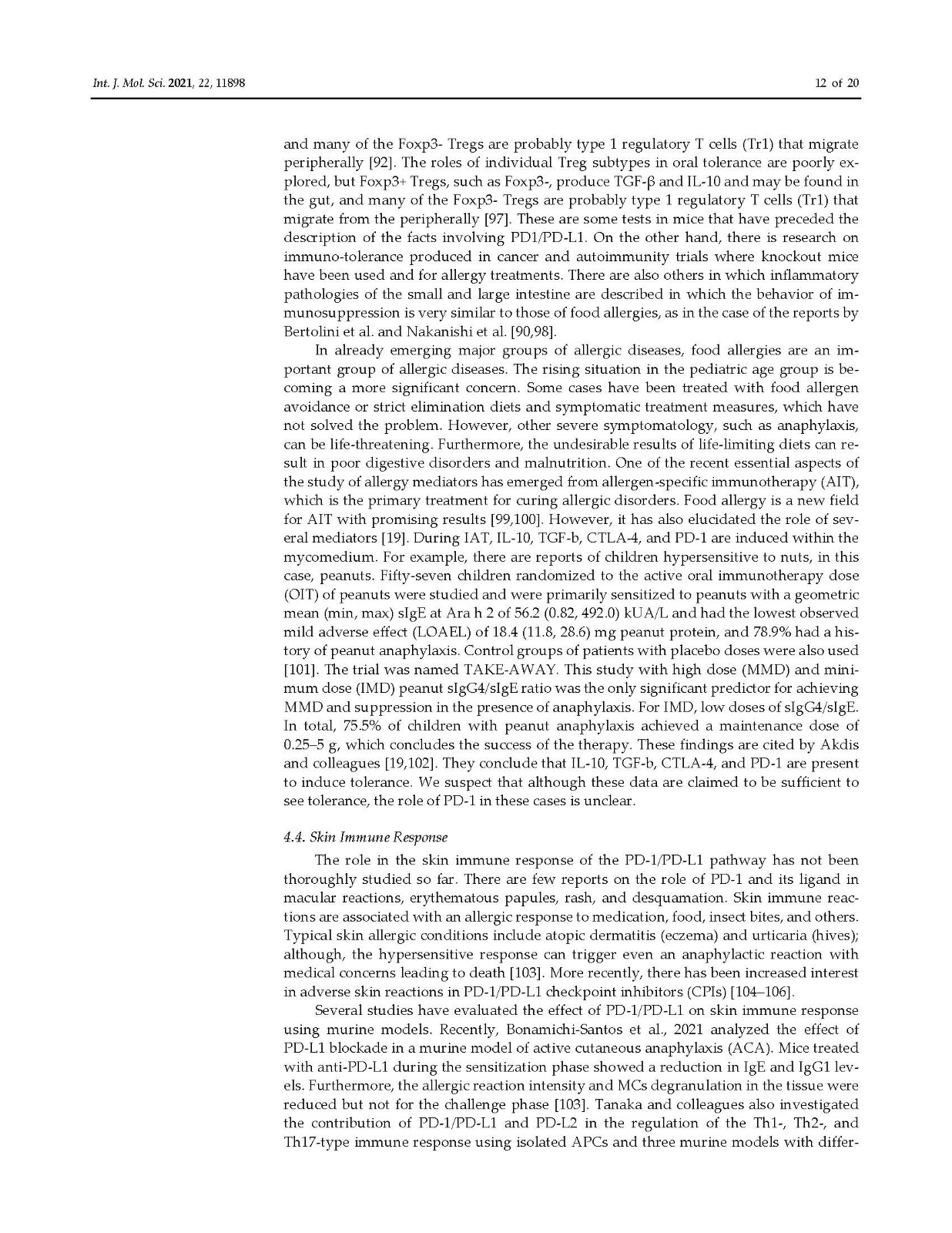Programmed cell death 1 (PD‐1) and its ligands PD‐L1 and PD‐L2 are receptors that act in co‐stimulatory and coinhibitory immune responses. Signaling the PD‐1/PD‐L1 or PD‐L2 pathway isessential to regulate the inflammatory responses to infections, autoimmunity, and allergies, and it has been extensively studied in cancer. Allergic diseases include asthma, rhinoconjunctivitis, atopic dermatitis, drug allergy, and anaphylaxis. These overactive immune responses involveIgE‐dependent activation and increased CD4+ T helper type 2 (Th2) lymphocytes. Recent studies have shown that PD‐L1 and PD‐L2 act to regulate T‐cell activation and function. However, the main role of PD‐1 and its ligands is to balance the immune response; however, the inflammatory process of allergic diseases is poorly understood. These immune checkpoint molecules can function as a brake or a kick‐start to regulate the adaptive immune response. These findings suggest that PD‐1 and its ligands may be a key factor in studying the exaggerated response in hypersensitivity reactions in allergies. This review summarizes the current understanding of the role of PD‐1 and PD‐L1 and PD‐L2 pathway regulation in allergic diseases and how this immunomodulatory pathway is currently being targeted to develop novel therapeutic immunotherapy.
程序性细胞死亡 1 (PD-1) 及其配体 PD-L1 和 PD-L2 是在共刺激和共抑制免疫反应中起作用的受体。向 PD-1/PD-L1 或 PD-L2 通路发出信号对于调节对感染、自身免疫和过敏的炎症反应至关重要,它已在癌症中得到广泛研究。过敏性疾病包括哮喘、鼻结膜炎、特应性皮炎、药物过敏和过敏反应。这些过度活跃的免疫反应涉及 IgE 依赖性激活和 CD4+ T 辅助 2 型 (Th2) 淋巴细胞增加。最近的研究表明,PD-L1 和 PD-L2 可调节 T 细胞的激活和功能。然而,PD-1及其配体的主要作用是平衡免疫反应;然而,人们对过敏性疾病的炎症过程知之甚少。这些免疫检查点分子可以起到刹车或启动的作用,以调节适应性免疫反应。这些发现表明,PD-1 及其配体可能是研究过敏症中超敏反应过度反应的关键因素。本综述总结了目前对 PD-1 和 PD-L1 以及 PD-L2 通路调节在过敏性疾病中的作用的理解,以及目前如何针对这种免疫调节通路开发新型治疗性免疫疗法。
CD4+ T cells require three complementary signals to become fully activated—the T‐cell receptor (TCR) signal, co‐stimulation/inhibition signals, and cytokine priming. The first signal confers specificity to the immune response and plays an essential role in rec‐ognizing antigen presentation by MHC‐II on the surface of APCs. However, this signal alone is not sufficient to fully activate these T cells. For full efficacy, T cells need a second,non‐specific co‐stimulatory signal. The coupling between APCs and naive T cells will signal surface molecules expressed on T cells and APCs. Both express co‐stimulatory molecules such as CD80 and CD86, which belong to the B7 family. These molecular in‐teractions modulate T cell function by binding to CD28 or cytotoxic T‐lymphocyte‐associated antigen 4 (CTLA‐4) receptors; this interaction has been ob‐served to have opposing effects depending on the different environmental signals.CTLA‐4 inhibits T‐cell responses and regulates peripheral T‐cell tolerance. At the sametime, CD28 promotes T‐cell activation and survival. Finally, cytokines control differenti‐ation into different effector cells that deliver signals such as IL‐4, IL‐5, IL‐13, INFs, and proinflammatory cytokines [1]. This finding shows that these immunological checkpoint molecules have a role in fine‐tuning the T‐cell response by mediating stimulatory and inhibitory signals.
CD4+ T细胞需要三种互补信号才能完全激活T细胞受体(TCR)信号,共刺激/抑制信号,细胞因子启动。的第一个信号赋予免疫反应特异性,并在应答中起重要作用通过MHC‐II识别apc表面的抗原呈递。然而,这个信号单独不足以完全激活这些T细胞。为了充分发挥功效,T细胞需要第二次,非地理公司应承担的刺激信号。apc和原始T细胞之间的结合会T细胞和APCs上表达的信号表面分子。都表达公司的刺激分子如CD80和CD86,它们属于B7家族。这些分子的量相互作用通过结合CD28或细胞毒性来调节T细胞功能T淋巴细胞相关抗原4 (CTLA - 4)受体;这种互动一直是ob‐根据不同的环境信号,会产生相反的效果。CTLA - 4抑制T细胞反应并调节外周T细胞耐受。在同一随着时间的推移,CD28促进T细胞的活化和存活。最后,细胞因子的控制是不同的IL - 4、IL - 5、IL - 13、inf和IL - 4等信号传递到不同的效应细胞中促炎细胞因子[1]。这一发现表明这些免疫检查点分子在通过介导刺激和调节T细胞反应中起着重要作用抑制信号。




















关键词 :allergy; PD‐1; PD‐L1; PD‐L2; asthma; BTLA; rhinoconjunctivitis; atopic dermatitis; food allergy; anaphylaxis
来源:MDPI https://www.mdpi.com/1422-0067/22/21/11898
上一篇: 细胞培养瓶使用注意这三点
下一篇: 血清瓶中的血清如何储存